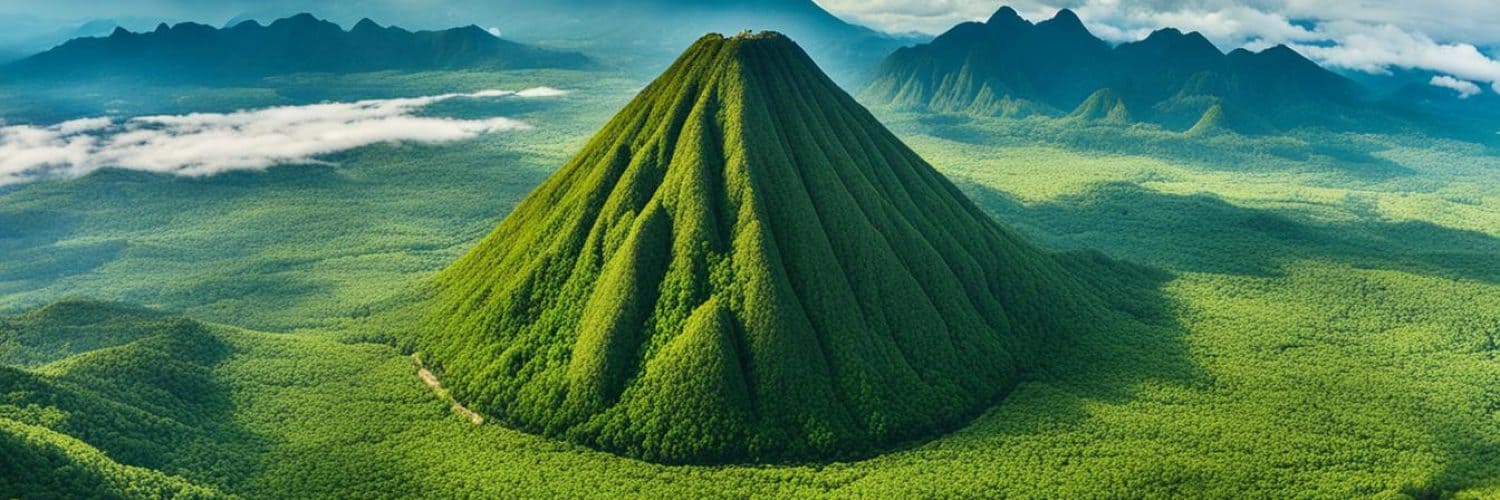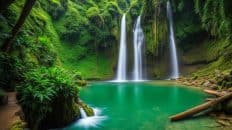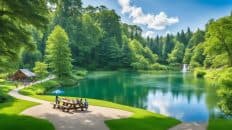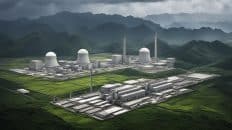Welcome to Mount Arayat National Park, a picturesque destination nestled in the heart of Pampanga, Philippines. This enchanting park offers a wealth of outdoor adventures, making it an ideal retreat for nature enthusiasts and thrill-seekers alike. From awe-inspiring hiking trails to serene camping spots, Mount Arayat National Park has something for everyone.
Immerse yourself in the beauty of nature as you explore the park’s extensive network of hiking trails. Take in breathtaking views of the surrounding landscape as you conquer the mountain’s peaks. For those seeking a more relaxed experience, the park offers tranquil picnic areas where you can enjoy a leisurely meal amidst the peaceful surroundings.
Mount Arayat National Park is not only a haven for outdoor enthusiasts, but also a sanctuary for wildlife. Bird watching enthusiasts will be delighted by the diverse array of bird species that call the park home. In addition, the park’s commitment to nature conservation ensures the preservation of its unique ecosystem.
Whether you’re an avid hiker, a nature lover, or simply in search of a quiet escape, Mount Arayat National Park is sure to captivate your heart and provide an unforgettable experience. Embark on an adventure, discover the wonders of this stunning destination, and create memories that will last a lifetime.
Key Takeaways:
- Mount Arayat National Park offers a range of outdoor activities, including hiking, camping, and bird watching.
- The park is a wildlife sanctuary, providing a home for diverse bird species and promoting nature conservation.
- Visitors can enjoy the tranquil picnic areas while immersing themselves in the park’s natural beauty.
- Mount Arayat National Park is an accessible retreat for nature lovers, located in Pampanga.
- Immerse yourself in the lush vegetation, cascading waterfalls, and breathtaking views of Mount Arayat National Park.
Location and Geography of Mount Arayat
Mount Arayat is a prominent natural landmark located in the province of Pampanga, within the Central Luzon region of the Philippines. Situated at precise coordinates 15°12′00″N 120°44′31″E, this magnificent mountain stands tall as a potentially active stratovolcano, boasting a height of 1,033 meters (3,389 ft).
The geography of Mount Arayat is captivating, with a breached crater on its northwest side adding to its distinctiveness. Beautiful basalt and andesite rock formations surround the mountain, creating a picturesque landscape of contrasting textures and colors. It is part of the Luzon Volcanic Arc, a chain of volcanoes that runs through the island of Luzon. The last eruption of Mount Arayat occurred during the Holocene period, contributing to the rich geological history of the area.
Mount Arayat’s strategic location within a flat agricultural region allows it to stand out as a prominent landmark. It is surrounded by other notable attractions, including the famous Mount Pinatubo, enhancing the overall allure of the area.
| Location | Geographical Coordinates | Mountain Type |
|---|---|---|
| Pampanga, Central Luzon, Philippines | 15°12′00″N 120°44′31″E | Stratovolcano |
History and Folklore of Mount Arayat
Mount Arayat carries a captivating history intertwined with the Philippine Revolution and World War II. During the Philippine Revolution, Mount Arayat served as a sanctuary for Filipino revolutionaries seeking shelter from the Spanish authorities. Similarly, it became a refuge for Filipino guerrillas during the tumultuous times of World War II.
But the mountain’s allure extends beyond its historical significance. It is steeped in folklore, with local legends claiming that Mount Arayat is the dwelling place of a mystical figure known as Aung/Aring Sinukuan. According to the tales, Aung/Aring Sinukuan rivals the deity of Mount Pinatubo and holds considerable power over the surrounding area.
The origins of Mount Arayat’s name can be traced back to a travel diary written by Gemelli Careri in 1696. The diary refers to the mountain as Bondo Kalaya, which later evolved into Bondoc Alaya and eventually Arayat.
“Mount Arayat carries a captivating history intertwined with the Philippine Revolution and World War II.”
Discovering the historical and mythical significance of Mount Arayat adds to the enchantment surrounding this remarkable natural wonder.
The Legend of Aung/Aring Sinukuan
According to Kapampangan mythology, Aung/Aring Sinukuan is a powerful figure believed to inhabit Mount Arayat. The legendary tale tells of a rivalry between Aung/Aring Sinukuan and the god of Mount Pinatubo, Apung Malyari. Their epic battles and mythical powers captivate the imagination, adding to the mystique of Mount Arayat. Many visitors and locals are drawn to Mount Arayat to witness the sacred waterfalls, such as those in Ayala, frequented by Aung/Aring Sinukuan as mentioned in the folklore.
Historical Significance in the Philippine Revolution and World War II
Throughout history, Mount Arayat has served as a crucial strategic location during times of conflict. In the Philippine Revolution, Filipino revolutionaries strategically retreated to the mountain to evade capture by the Spanish authorities. The mountain’s rugged terrain and dense vegetation provided a safe haven for these brave fighters.
During World War II, Mount Arayat became a covert hideout for Filipino guerrillas, allowing them to launch surprise attacks and undermine the occupying Japanese forces. The mountain’s vast expanse and intricate network of trails made it an ideal refuge for guerrilla fighters, enabling them to mount effective resistance efforts.
The historical significance of Mount Arayat highlights its role as a symbol of resilience and resistance in the face of adversity.
Geology of Mount Arayat
The impressive Mount Arayat in Pampanga is a stratovolcano that showcases fascinating geological features. At its northwest side, it boasts a collapsed crater, adding to its allure. Within this crater, you’ll find a smaller andesitic dome known as White Rock. The mountain is predominantly composed of basalt and andesite rock types, which contribute to its unique formation and character.
While there are no cultural records of historical eruptions, the mountain exhibits signs of weak steaming in some of its heavily eroded vents. These natural phenomena highlight the volcanic activity that once shaped Mount Arayat. The rocks found on the mountain date back between 0.53 and 0.65 million years old, providing evidence of its ancient origins.
Mount Arayat is considered a single-cone stratovolcano, with its peaks seamlessly merged at the top. This remarkable geological formation adds to the mountain’s visual appeal and makes it an iconic natural landmark in the region.
Hiking Trails and Outdoor Activities
Mount Arayat National Park in Pampanga offers a plethora of exciting outdoor activities and hiking trails for nature enthusiasts to explore and enjoy. The park provides a range of options that cater to different preferences and skill levels, ensuring there is something for everyone.
Southern Peak Trail
The southern peak trail is one of the main hiking trails in Mount Arayat National Park, accessible from the municipality of Arayat. This trail takes approximately 3-4 hours to reach the peak, offering hikers breathtaking panoramic views of the stunning landscapes of Central Luzon. As you ascend, you’ll be treated to awe-inspiring sights, including the meandering Pampanga River and the majestic mountains of Zambales and Bataan.
With every step, you’ll feel closer to nature, surrounded by the park’s lush vegetation and diverse wildlife. As you reach the peak, take a moment to soak in the beauty of the surrounding vistas, marveling at the splendor of the natural world.
Northern Peak Trail
The northern peak trail is another popular route that leads to the peaks of Mount Arayat. This trail can be accessed from the municipality of Magalang and offers a similar hiking duration as the southern peak trail.
Along this trail, hikers will pass through the iconic Arayat Amphitheatre, a historical landmark that adds cultural significance to the journey. The trail also takes you to the famous White Rock, believed to be the dwelling place of Aung/Aring Sinukuan, a mystical figure in local folklore.
As you hike through the northern peak trail, you’ll experience the wonders of nature and immerse yourself in the surrounding beauty. The captivating views and unique landmarks along the way make this trail a must-visit for adventurers seeking a memorable outdoor experience.
Additional Trails and Scenic Viewpoints
In addition to the main peaks, Mount Arayat National Park offers other trails that provide different hiking experiences and picturesque viewpoints to explore. The Pinnacle and TKO trails are popular choices for those looking for alternative routes and hidden gems within the park.
Throughout these trails, you’ll encounter stunning natural features, including cascading waterfalls, serene fish ponds, and inviting swimming pools. These recreational amenities are perfect for a refreshing break during your hiking adventure or as a relaxing spot to unwind and appreciate the beauty of nature.
Whether you’re a passionate hiker or an outdoor enthusiast seeking new adventures, the hiking trails and outdoor activities in Mount Arayat National Park are sure to leave you with unforgettable memories and a deeper appreciation for the wonders of the natural world.
Wildlife and Conservation
The Mount Arayat National Park in Pampanga is not just a picturesque destination; it also serves as a wildlife sanctuary, providing a safe haven for a diverse range of flora and fauna. Within the park’s boundaries, visitors can encounter a variety of endemic and endangered species, contributing to the rich biodiversity of the area.
The conservation efforts at Mount Arayat National Park play a crucial role in preserving natural resources and maintaining the delicate balance of the ecosystem. By protecting the park’s flora and fauna, conservationists ensure the long-term survival and thriving of these valuable species.
:”The natural beauty and biodiversity found in Mount Arayat National Park are worth protecting. Through our conservation efforts, we aim to preserve the delicate balance of the ecosystem and promote the sustainability of the park’s natural resources.”
-Gabriel Santos, Conservation Biologist
Conservationists and park authorities encourage visitors to respect the environment and follow designated trails when exploring the park. This helps minimize human impact on the natural habitat and aids in the preservation of the delicate ecosystem.
Flora and Fauna at Mount Arayat National Park
The park boasts a wide array of plant species, including towering trees, vibrant flowers, and lush vegetation. The diverse flora provides food and shelter for numerous animal species, contributing to the overall biodiversity of the park.
As for the fauna, Mount Arayat National Park is home to various mammals, birds, reptiles, and amphibians. Some notable species found within the park include the Philippine deer (Rusa marianna), Luzon bleeding-heart dove (Gallicolumba luzonica), Philippine warty pig (Sus philippensis), and Luzon water monitor (Varanus marmoratus).
The image above showcases the diverse wildlife that can be observed within the park, highlighting the importance of its conservation efforts.
| Flora | Fauna |
|---|---|
|
|
The table above showcases some of the remarkable flora and fauna species that can be found within Mount Arayat National Park.
By promoting awareness about the importance of conservation and supporting ongoing efforts, visitors and the local community contribute to the long-term preservation of Mount Arayat National Park and its invaluable natural resources.
Picnic Areas and Recreational Facilities
When visiting Mount Arayat National Park in Pampanga, visitors are spoiled for choice when it comes to picnic areas and recreational facilities. The park’s stunning natural surroundings provide a serene backdrop for picnics and relaxation, allowing visitors to unwind and connect with nature. Whether you prefer a riverside setting or a shady spot under the trees, Mount Arayat offers a variety of picnic areas to suit every preference.
For those seeking recreational activities, the park boasts a range of facilities to enhance your experience. Immerse yourself in the beauty of the park’s waterfalls, where you can marvel at the cascading water and enjoy the soothing sounds of nature. The fish ponds provide an opportunity to observe aquatic life and connect with the biodiversity of the park. And for those looking to beat the heat, the swimming pools offer a refreshing escape.
| Picnic Areas | Recreational Facilities |
|---|---|
|
|
These facilities are strategically located throughout the park, allowing visitors to fully immerse themselves in the natural beauty of Mount Arayat. Whether you’re enjoying a leisurely picnic with loved ones or seeking adventure in the park’s recreational areas, Mount Arayat offers a memorable experience for all.
Importance of Mount Arayat’s Water Resources
Mount Arayat National Park in Pampanga acts as a crucial provider of water resources for both domestic and agricultural use. With its 23 creeks serving as a water source for irrigation, and an estimated 350,000 hectares of rice fields surrounding the area, the park plays a vital role in sustaining local agriculture.
The Pampanga River, the second largest river in Luzon, flows at the foot of Mount Arayat, further contributing to the region’s water supply. This river serves as a crucial water source for the provinces of Bulacan, Pampanga, and Nueva Ecija.
Given the agricultural importance of the region, the preservation and conservation of Mount Arayat’s water resources are of utmost significance. By safeguarding these resources, local communities can rely on a sustainable and reliable supply of water for their irrigation needs and domestic use.
| Water Resources | Usage |
|---|---|
| 23 creeks | Irrigation |
| Pampanga River | Crucial water source for Bulacan, Pampanga, and Nueva Ecija |
Cultural Significance and Folklore Surrounding Mount Arayat
Mount Arayat, located in Pampanga, holds a significant place in local culture and is deeply intertwined with folklore and mythology. According to Kapampangan legends, the mountain is believed to be the home of the powerful god or sorcerer known as Sinukuan or Sinukwan. Sinukuan is considered a rival to Apung Malyari, the god of Mount Pinatubo.
The rich folklore surrounding Mount Arayat adds to its allure, drawing tourists and locals alike to explore its mystical tales. The mountain’s waterfalls, particularly those found in Ayala, are believed to be Sinukuan’s bathing quarters, making them popular destinations for visitors seeking a connection with the region’s cultural heritage.
“Mount Arayat, with its captivating folklore, offers a glimpse into the vibrant Kapampangan mythology, showcasing the rich cultural heritage of the region.”
The tales of Sinukuan and the unique cultural significance of Mount Arayat contribute to the enchantment and prestige of this natural wonder. Visitors to the Mount Arayat National Park are given the opportunity to immerse themselves in the captivating folklore and experience firsthand the cultural richness of the area.
Future Challenges and Conservation Efforts
Mount Arayat National Park in Pampanga faces an ongoing challenge in the form of deforestation, which poses a significant threat to its delicate ecosystem. The loss of forest cover not only disrupts the natural beauty of the park but also contributes to soil erosion, habitat degradation, and the loss of biodiversity. To combat these challenges, dedicated conservation efforts are being implemented to preserve the ecological balance and protect the park’s invaluable resources.
One of the primary initiatives is reforestation, where trees are replanted to restore the forest cover that has been lost due to deforestation. This helps in stabilizing soil, preventing erosion, and providing a conducive environment for the plant and animal species that call Mount Arayat their home.
Sustainable land management practices are also being adopted to mitigate the impacts of deforestation. By practicing responsible land use and implementing measures such as proper land rotation and soil conservation methods, the park can maintain its ecological integrity and ensure the long-term health of its ecosystems.
The success of these conservation efforts relies not only on the dedicated work of organizations and environmental agencies but also on the active participation of the local community and visitors to the park. By raising awareness about the importance of conservation and promoting sustainable practices, together, we can help protect the natural wonders of Mount Arayat National Park, safeguarding them for generations to come.
Let us work hand in hand to conserve this precious natural heritage and secure a vibrant and sustainable future for Mount Arayat National Park.
Visitor Information and Guidelines
When planning a visit to Mount Arayat National Park in Pampanga, it is important to familiarize yourself with the visitor information and guidelines to ensure a safe and enjoyable experience. Here are some key guidelines to follow:
- Stay on Designated Trails: To minimize disturbance to the natural environment, it is essential to stay on the designated trails while exploring the park. This helps protect the delicate ecosystem and ensures the preservation of the park’s beauty.
- Practice Responsible Tourism: As responsible visitors, it is crucial to abide by the park’s rules and regulations. This includes not littering, avoiding damage to vegetation, and being mindful of the wildlife. By practicing responsible tourism, we can contribute to the preservation and conservation of Mount Arayat National Park.
- Come Prepared: Before embarking on your outdoor adventure, make sure to come prepared with appropriate clothing, footwear, water, and snacks. The weather in the area can be unpredictable, so it’s advisable to bring layers and necessary supplies for your comfort and safety.
“Responsible tourism is not only about leaving no trace but also about making a positive impact on the environment and local communities. Let us all do our part in preserving the natural beauty of Mount Arayat National Park for future generations to enjoy.”
By adhering to these guidelines and being responsible visitors, we can all contribute to the preservation and conservation of Mount Arayat National Park. Let’s cherish this magnificent natural wonder and create lasting memories while respecting its beauty and significance.
| Visitor Information and Guidelines | Important Points |
|---|---|
| Stay on Designated Trails | Minimize disturbance to the environment and preserve the park’s beauty. |
| Practice Responsible Tourism | Do not litter, avoid damaging vegetation, and respect wildlife. |
| Come Prepared | Wear appropriate clothing, bring water, snacks, and necessary supplies. |
Conclusion
Mount Arayat National Park in Pampanga is a haven for nature enthusiasts seeking outdoor adventures and a deep connection with the natural world. The park’s breathtaking natural beauty, diverse wildlife, and rich cultural heritage make it a truly special destination. Visitors can immerse themselves in a range of activities, from hiking along scenic trails and camping under the stars to bird watching and indulging in peaceful picnics amidst the lush surroundings.
Moreover, Mount Arayat National Park serves as a vital sanctuary for a variety of plant and animal species, contributing to the conservation efforts and preservation of Pampanga’s natural resources. By appreciating and respecting this treasure, we can all play a role in ensuring its long-lasting beauty and ecological balance for future generations to cherish.
Whether you are captivated by the breathtaking vistas, fascinated by the region’s folklore and cultural significance, or simply seeking outdoor adventures, Mount Arayat National Park in Pampanga is a destination that offers something for everyone. By embracing responsible tourism practices and embracing the park’s natural and cultural wonders, you can create lasting memories while helping to protect this remarkable treasure.
FAQ
What is Mount Arayat National Park?
Mount Arayat National Park is a mystical and accessible park located in Pampanga, Philippines. It features a circular volcanic crater at the summit, surrounded by lush vegetation and waterfalls. The park is a wildlife sanctuary, offering activities such as hiking, camping, bird watching, and more.
Where is Mount Arayat National Park located?
Mount Arayat National Park is situated in the province of Pampanga, within the Central Luzon region of the Philippines. Its precise coordinates are 15°12′00″N 120°44′31″E. The park is surrounded by notable landmarks such as Mount Pinatubo.
What is the history and folklore of Mount Arayat?
Mount Arayat has a rich history dating back to the Philippine Revolution and World War II. It served as a refuge for Filipino revolutionaries and guerrillas during these periods. In local folklore, the mountain is believed to be the home of a mystical figure called Aung/Aring Sinukuan, rivaling the god of Mount Pinatubo.
What is the geology of Mount Arayat?
Mount Arayat is a stratovolcano with a collapsed crater on its northwest side. It features a lava dome known as White Rock within the crater. The mountain is composed of basalt and andesite rocks. While there are no historical records of eruptions, weak steaming can be observed. The age of the rocks dates back to around 0.53 to 0.65 million years old.
What hiking trails and outdoor activities are available in Mount Arayat National Park?
Mount Arayat National Park offers two main trails that lead to the peaks of the mountain. The southern peak trail can be accessed from the municipality of Arayat, while the northern peak trail can be accessed from the municipality of Magalang. Other trails, such as the Pinnacle and TKO trails, provide different hiking experiences. The park also offers scenic viewpoints and the Arayat Amphitheatre.
What wildlife can be found in Mount Arayat National Park?
Mount Arayat National Park serves as a wildlife sanctuary and is home to a wide variety of flora and fauna, including endemic and endangered species. The park plays a crucial role in conservation efforts and aims to preserve the natural resources and biodiversity within its boundaries.
Are there picnic areas and recreational facilities in Mount Arayat National Park?
Yes, Mount Arayat National Park offers picnic areas surrounded by lush foliage, providing a serene setting for picnics and relaxation. The park also features waterfalls, fish ponds, and swimming pools, enhancing the overall experience for visitors.
What is the importance of Mount Arayat’s water resources?
Mount Arayat provides water resources for both domestic and agricultural use. The park is home to 23 creeks that supply water for irrigation and an estimated 350,000 hectares of rice fields in the area. The Pampanga River, which flows at the foot of Mount Arayat, serves as a crucial water source for surrounding provinces.
What is the cultural significance and folklore surrounding Mount Arayat?
According to Kapampangan mythology, Mount Arayat is believed to be the home of the god/sorcerer named Sinukuan/Sinukwan. Sinukuan is considered a powerful figure and a rival to the god of Mount Pinatubo. The mountain’s waterfalls, such as those in Ayala, are believed to be Sinukuan’s bathing quarters.
What future challenges and conservation efforts are associated with Mount Arayat?
Mount Arayat faces the ongoing challenge of deforestation, which poses a threat to its delicate ecosystem. Conservation efforts, such as reforestation and sustainable land management practices, are being implemented to mitigate the impacts of deforestation and preserve the natural beauty of the park.
What guidelines should visitors follow when visiting Mount Arayat National Park?
When visiting Mount Arayat National Park, visitors should stay on designated trails to minimize disturbance to the environment. Responsible tourism practices, such as not littering and respecting park rules and regulations, are encouraged. Visitors should also come prepared with appropriate clothing, water, and snacks for their outdoor activities.
Why should I visit Mount Arayat National Park?
Mount Arayat National Park offers a unique and unforgettable experience for nature lovers and outdoor enthusiasts. With its stunning natural beauty, diverse wildlife, and rich cultural heritage, the park provides a range of activities, from hiking and camping to bird watching and picnicking. It also serves as a sanctuary for flora and fauna and plays a vital role in conservation efforts.


















Add comment